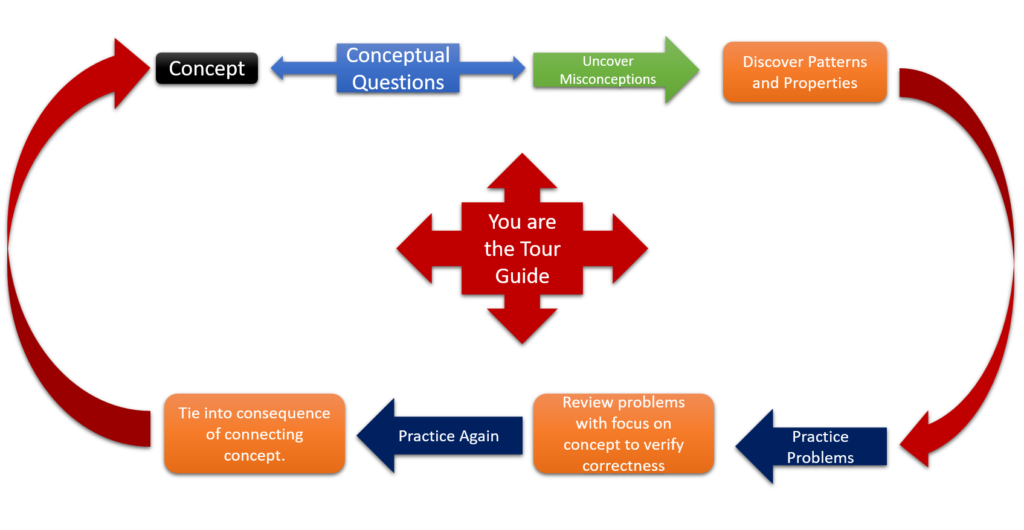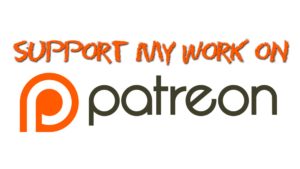Focus on Conceptual Understanding
Flow Chart
for
Educators
Teaching by concept alone will lead to inefficiencies in students. They will, in effect, be reinventing a large part of the wheel at every turn. (See what I did there?) We have all witness what focus on procedure alone does. It leaves students will a bunch of isolated skills that they do not recognize out of context. Out of context here literally means changing the font or using a different set of variables.
An example is the topic/skill of finding the lowest common multiple of greatest common factor. Students are well versed in many procedures, yet of course, mix the two up. That is, they’ll claim a GCF (greatest common factor) is a LCM (lowest common multiple). This is NOT their fault. They don’t understand the difference between a multiple and a factor. They don’t see how those two are applied in other mathematical calculations, even though in order to perform the majority of operations with fractions, those are required.
The focus in education has shifted, and like large bodies do, they swing too far. More than likely the focus has been too great on concept and avoidance of procedure and rote memory of basic math facts. That’s a discussion for another time.
I’d like to help you, the teacher, strike a good balance. Unlike big publishers or professional development companies, I am in the classroom, trying these methods with all of my topics and a wide variety of students. It is highly successful.
One key component of the success is removing yourself from the role of, “The Human Wikipedia,” in the room. Think of yourself more as a coach than a teacher. The knowledge you possess cannot be possessed by the students simply by you telling or explaining what you know to them. They must experience it themselves and grapple with the misconceptions to make sense of things. You’re a facilitator of discussions and explorations, and quite importantly, you’re a guide. No need to chase too many rabbit holes. When a level of understanding is achieved it is up to you to help bring closure, probably through a discussion and writing activity where students write down their explanations of what they’ve learned. Then, that’s when homework changes from uncovering misconceptions to solidifying understanding and making efficient processes that are repeatable.
I’ve harped on many of those things in the past. If you have questions about any of those ways in which homework is used to help learning, please feel free to leave a comment or send an email.
With all of that said, let’s get into it. The chart at below is a general idea of how concept can be established and explored, how procedures can be introduced as a way of generalizing patterns and features of the concept, and last, how that concept can be used to introduce a connecting concept, or consequence of that concept.

Here’s the idea. The rectangular shapes are lessons, or whole group discussions. Everything with an arrow is student work where your job is to encourage and direct. Typically, it is a bad idea to explain things during this time. Instead, encourage students to find other students in the room that they trust that might be able to explain what it is that’s confusing them.
Another big idea during this time is to encourage students to articulate what it is that is confusing them. When students say, “I don’t get it,” they’re helpless. They’re not even thinking about what is causing trouble. By forcing them to reflect on what’s causing the trouble, they’ll likely find their way through the confusion. For you to step in and let them off the hook will only make them have to face that point of confusion later, and it will be bigger and the nature of the confusion will be less clear to them.
A great topic to use an example of this works is exponents. All of the “rules” of exponents come from the idea that exponents are repeated multiplication, of the same number. The difficulty in exponents comes from students inability to read the notation properly, especially when groups are involved.
Let’s briefly explore how this chart can help guide your planning with something like exponents.
Concept: Introduce the notation, perhaps tying it in to how multiplication is written to describe repeated addition of the same number.
3 × 5 = 3 + 3 + 3 + 3 + 3
35 = 3 × 3 × 3 × 3 × 3
Some conceptual questions would be things like providing three different expressions written with exponents and having the students pick the two that are the same. Another way to do this is to give the students an expression and then give them a choice of five other expressions, often which may contain more than one equivalent expression, and have the students pick which match.
During such matching activities keep in mind that the students having the right answer is not necessarily a reflection of understanding. Without the proper explanation, accurate and concise, they likely do not know. Their results of being right will not be repeatable.
Also, when exploring things like this, tell the students that they should write down the examples, but students that will learn will focus most of their notes on their thoughts and questions. This is especially true since we are NOT discussing procedure.
(If you’d like to see some examples of these types of conceptual questions you can find them in the PowerPoint attached here.)
During the questioning of concepts you should chase misconceptions and show how they do not match up with what is true. Always focus on the fact that it is through mistakes that students are learning. Thank students, praise them for participating even when they’re not sure they’re right. We all hate being wrong, and students are often insecure and fear being judged harshly for being wrong.
After exploring the misconceptions and then finding patterns and developing some procedure it is a good time for them to practice what they’ve learned, AKA, homework.
When reviewing the homework the next day make sure things are determined right or wrong by referring to the concept, not finding mistakes in procedure. Of course some refinement of procedure is appropriate when reviewing homework, but that should be for the sake of efficiency, not understanding! This is likely a huge shift for teacher and student!
An in-class, open note pop-quiz is a good follow up, depending on the ability of the students and complexity of the topic. If I were to do such an activity, I would make sure the grades are not too punitive, providing credit to those that correct errors, or perhaps grade it like homework, on completion, not correctness.
If that in-class pop-quiz doesn’t work, a subsequent, more complicated homework assignment is in order. This next assignment should change the language of what’s being learned. Rephrase instructions or change some of the look of the problems so that students are not finding false clues by recognizing patterns in the problems themselves that have more to do with you, or the author of the work, than the concept at hand.
It is also a good idea to throw a few problems that tie into the next topic in, stretch problems, you could call them. Use reviewing these problems to introduce the next concept. I often do this without telling the students the new lesson has begun. It works well because students should be taking notes on their homework assignment in pen (not erasing mistakes but instead annotating them).
Two observations about these practices.
- Student involvement is key. Of course, students don’t learn if they’re not involved, but their involvement is less needed for a tradition, stand up and lecture while students take notes, type of classroom setting. These methods are truly student focused and student driven.
As the teacher you must anticipate the questions and points of confusion. Do not have answers at the ready, but perhaps simple problems that students can explore so they can discover clarity. Be ready to show a consequence of their misconceptions or perhaps a problem that simplifies their misconception so they can see it.
- Textbooks are woefully inadequate as a resource here. You need many books and resources in order to provide students with exposure to concepts, conceptual problems, and different levels of practice problems (the last practice problems can often come from books). The last set of problems, the stretch problems that connect what they’ve learned with what is coming next I have never seen in a textbook.
You’re going to have to be creative. I am trying to publish my materials and questions as I go through this year, but even so, they relate closely to my interpretation and view of the topic, the heuristic framework I developed. Yours is likely different and so the ways in which you can stretch understanding or expose misconception will vary slightly.
I hope this has been helpful. It is something I hope to explore more fully and deeply. Whenever I have been able to employ these methods the results have been powerful. Students learn and they retain their learning. I’ve been refining these methods over the past six years or so and my students have realized great success from it.
I thank you again for reading and hope this helps. Please let me know what questions you have, just leave a comment.
Philip Brown



